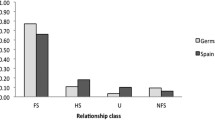Summary
Genetic parentage of 135 nestlings from 27 broods of polygynous and monogamous pied flycatchers Ficedula hypoleuca was analyzed by means of multilocus DNA fingerprinting. The minisatellite probe alpha-globin 3′HVR detected approximately 12 scorable bands per fingerprint, and the proportion of bands shared between presumably unrelated adults averaged 0.22+0.08 SD. The fingerprints of 125 of the 135 nestlings made a complete match to those of their putative parents. In 4 nestlings a single mismatched band occurred, but since band sharing with both putative parents was high, the single mismatches were assumed to be caused by mutation. The 6 remaining nestlings had 5 or more mismatched bands each, low band-sharing proportions with their putative father and high band-sharing proportions with their putative mother. We thus conclude that they were all sired through extra-pair copulations (EPCs). Hence, only 4% of nestlings were sired through EPCs, and none resulted from intraspecific brood parasitism. One of the cuckolding males was identified, explaining all 5 mismatched bands in the nestling's fingerprint. Three of the illegitimate nestlings were from primary nests of polygynous males; 3 were from nests of monogamous males. The fact that many males in this study started to advertise for a second female in a distant territory several days before their first mate began egglaying, and still managed to secure almost exclusive paternity in their first brood, suggests that male polyterritoriality is not costly in terms of lost paternity. Common anti-cuckoddry tactics performed by male birds, like high rate of within-pair copulation and continuous mate-guarding thoughout the female's fertilizable period, do not seem to be important in pied flycatchers.
Similar content being viewed by others
References
Alatalo RV, Gustafsson L, Lundberg A (1984) High frequency of cuckoldry in pied and collared flycatchers. Oikos 42:41–47
Alatalo RV, Gottlander K, Lundberg A (1987) Extra-pair copulations and mate-guarding in the polyterritorial pied flycatcher Ficedula hypoleuca. Behaviour 101:139–155
Alatalo RV, Gustafsson L, Lundberg A (1989) Extra-pair paternity and heritability estimates of tarsus length in pied and collared flycatchers. Oikos 56:54–58
Birkhead TR (1988) Behavioral aspects of sperm competition in birds. Adv Study Behav 18:35–72
Birkhead TR, Atkin L, Møller AP (1987) Copulation behaviour of birds. Behaviour 101:101–138
Birkhead TR, Pellatt J, Hunter FM (1988) Extra-pair copulation and sperm competition in the zebra finch. Nature 334:60–62
Björklund M, Westman B (1983) Extra-pair copulations in the pied flycatcher (Ficedula hypoleuca). A removal experiment. Behav Ecol Sociobiol 13:271–275
Burke T (1989) DNA fingerprinting and other methods for the study of mating success. Trends Ecol Evol 4:139–144
Burke T, Bruford MW (1987) DNA-fingerprinting in birds. Nature 327:149–153
Burke T, Davies NB, Bruford MW, Hatchwell B (1989) Parental care and mating behaviour of polyandrous dunnocks Prunella modularis related to paternity by DNA fingerprinting. Nature 338:249–251
Church GM, Gilbert W (1984) Genomic sequencing. Proc Natl Acad Sci USA 81:1991–1995
Ford NL (1983) Variation in mate fidelity in monogamous birds. Curr Ornithol 1:329–356
Fowler SM, Gill P, Werrett DJ, Higgs DR (1988) Individual specific DNA fingerprints from a hypervariable region probe: alphaglobin 3′HVR. Hum Genet 79:142–146
Gladstone DE (1979) Promiscuity in monogamous colonial birds. Am Nat 114:545–557
Gyllensten UB, Jakobsson S, Temrin H (1990) No evidence for illegitimate young in monogamous and polygynous warblers. Nature 343:168–170
Haartman L von (1951) Successive polygamy. Behaviour 3:256–274
Haartman L von (1956) Territory in the pied flycatcher Muscicapa hypoleuca. Behaviour 98:460–475
Higgs DR, Goodbourn SEY, Wainscoat JS, Clegg JB, Weatherall DJ (1981) Highly variable regions flank the human α-globin genes. Nucleic Acids Res 9:4213–4214
Jeffreys AJ, Wilson V, Thein SL (1985) Individual-specific “fingerprints” of human DNA. Nature 316:76–79
Jeffreys AJ, Wilson V, Thein SL, Weatherall DJ, Ponder BAJ (1986) DNA “fingerprints” and segregation analysis of multiple markers in human pedigrees. Am J Hum Genet 39:11–24
Lifjeld JT, Slagsvold T (1989a) How frequent is cuckoldry in pied flycatchers Ficedula hypoleuca? Problems with the use of heritability estimates of tarsus length. Oikos 54:205–210
Lifjeld JT, Slagsvold T (1989b) Allocation of parental investment by polygynous pied flycatcher males. Ornis Fenn 66:3–14
McKinney F, Cheng KM, Bruggers D (1984) Sperm competition in apparently monogamous birds. In: Smith RL (ed) Sperm competition and the evolution of avian mating systems. Academic Press, New York, pp 523–545
Møller AP (1989) Frequency of extra-pair paternity in birds estimated from sex-differential heritability of tarsus length: reply to Lifeld and Slagsvold's critique. Oikos 56:247–249
Quinn TW, White BN (1987) Identification of restriction fragment length polymorphism in genomic DNA of the lesser snow goose (Anser c. caerulescens). Mol Biol Evol 4:126–143
Quinn TW, Quinn JS, Cooke F, White BN (1987) DNA marker analysis detects multiple maternity and paternity in single broods of the lesser snow goose. Nature 326:392–394
Sherman PW, Morton ML (1988) Extra-pair fertilization in mountain white-crowned sparrows. Behav Ecol Sociobiol 22:413–420
Slagsvold T (1986) Asynchronous versus synchronous hatching in birds: experiments with the pied flycatcher. J Anim Ecol 55:1115–1134
Slagsvold T, Lifjeld JT (1988) Why are some birds polyterritorial? J Anim Ecol 130:65–68
Westneat DF (1987) Extra-pair fertilizations in a predominantly monogamous bird: genetic evidence. Anim Behav 5:877–886
Westneat DF (1990) Genetic parentage in the indigo bunting: a study using DNA Fingerprinting. Behav Ecol Sociobiol 27:67–76
Westneat DF, Sherman PW, Morton ML (1990) The ecology and evolution of extra-pair copulations in birds. Curr Ornithol 7:331–369
Wetton JH, Carter RE, Parkin DT, Walters D (1987) Demographic study of a wild house sparrow population by DNA fingerprinting. Nature 327:147–149
Author information
Authors and Affiliations
Additional information
Offprint requests to: J.T. Lifjeld
Rights and permissions
About this article
Cite this article
Lifjeld, J.T., Slagsvold, T. & Lampe, H.M. Low frequency of extra-pair paternity in pied flycatchers revealed by DNA fingerprinting. Behav Ecol Sociobiol 29, 95–101 (1991). https://doi.org/10.1007/BF00166483
Received:
Accepted:
Issue Date:
DOI: https://doi.org/10.1007/BF00166483



